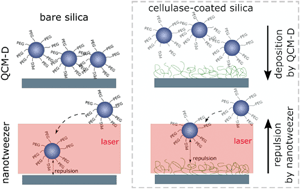QCM-D and NanoTweezer measurements to characterize the effect of soil cellulase on the deposition of PEG-coated TiO2 nanoparticles in model subsurface environments†
Abstract
Upon release to the environment, engineered nanoparticles (ENPs) undergo several chemical, physical and biological transformations that may affect their fate, transport, and bioavailability. The impact of ENP transformations (e.g., coating with natural organic matter or heteroaggregation with natural colloids) on ENP fate and transport has been systematically examined; however, the influence of soil enzymes that are ubiquitous in soils has not been considered. In this study, we examined the effect of a model extracellular soil enzyme (cellulase) – either free in an artificial porewater or adsorbed on a model aquifer grain (silica) surface – on the deposition kinetics of polyethylene glycol-coated titanium dioxide nanoparticles (PEG-nTiO2). A quartz crystal microbalance with dissipation monitoring (QCM-D) was used to study the interaction of PEG-nTiO2 with bare and cellulase-coated silica surfaces as well as in the presence of free cellulase over a range of sodium chloride concentrations. Significant reduction in PEG-nTiO2 deposition rates was observed in the presence of cellulase indicative of strong repulsive interactions between the nanoparticles and the layer of cellulase adsorbed on the silica surface. QCM-D observations were supported by measurements of the PEG-nTiO2–surface interaction energies using an optical NanoTweezer apparatus revealing more repulsive particle–surface interaction energies for the cellulase-coated silica. QCM-D measurements also indicated formation of more viscoelastic films in the presence of cellulase compared to bare silica except at the lowest ionic strength (IS) studied (10 mM NaCl). Overall, this work shows the potential for increased mobility of ENPs in subsurface environments in the presence of extracellular soil enzymes, motivating the need for further studies on the fate and behaviour of ENPs in the presence of these ubiquitous biomolecules.



 Please wait while we load your content...
Please wait while we load your content...